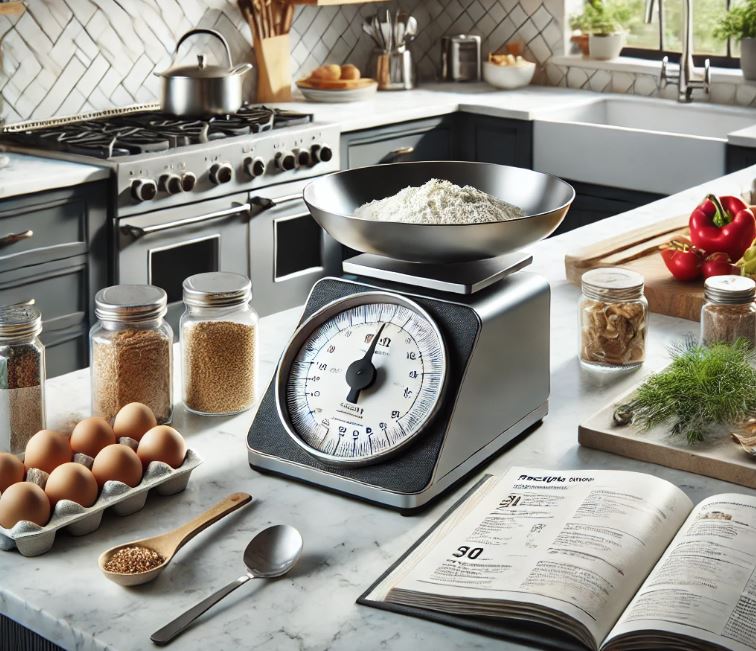I'm a participant in the Amazon Services LLC Associates Program, an affiliate advertising program designed to provide a means for me to earn fees by linking to Amazon.com and affiliated sites.
Using a food scale can revolutionize your cooking and baking, ensuring precise measurements for better results. Whether you’re following a recipe that requires exact measurements or tracking your food intake for dietary reasons, understanding how to use a food scale is essential. This guide will walk you through the steps to effectively use a food scale, providing tips and insights to make the most of this valuable kitchen tool.
Not sure if you have the right food scale for your needs? Check out our guide on the best kitchen scales for some help.
Key Takeaways
- A food scale ensures precise measurements for cooking, baking, and dietary tracking.
- Different types of scales offer various features; understanding these can help choose the right one.
- Proper use and maintenance of a food scale enhance its accuracy and longevity.
Choosing the Right Food Scale
Types of Food Scales
There are two main types of food scales: digital and mechanical. Digital scales provide quick and accurate readings, often with additional features like tare functions and unit conversions. Mechanical scales, while less precise, can be a good choice for those who prefer a more traditional approach.
Features to Consider
When selecting a food scale, consider features such as:
- Tare Function: Allows you to subtract the weight of the container.
- Measurement Units: Ability to switch between grams, ounces, and milliliters.
- Capacity: Ensure the scale can handle the maximum weight you plan to measure.
- Display: A large, backlit display is easier to read.
How to Use a Food Scale
Step-by-Step Guide
- Place the Scale on a Flat Surface: Ensure the scale is on a stable, flat surface for accurate measurements.
- Turn On the Scale: Power on the scale and wait for it to reset to zero.
- Select Measurement Unit: Choose the unit of measurement (grams, ounces, etc.) based on your needs.
- Use the Tare Function: Place the empty container on the scale and press the tare button to zero out the weight.
- Add Food to the Container: Gradually add the food until you reach the desired weight. The scale will display the weight of the food only.
Tips for Accurate Measurements
- Consistent Placement: Always place the food in the center of the scale.
- Avoid Overloading: Do not exceed the maximum capacity of the scale.
- Use Appropriate Containers: Choose containers that fit well on the scale and do not obscure the display.
Maintaining Your Food Scale
Cleaning and Storage
- Regular Cleaning: Wipe the scale with a damp cloth after each use. Avoid submerging it in water.
- Proper Storage: Store the scale in a dry place to prevent damage from moisture.
Calibration
- Regular Calibration: Check the scale’s accuracy periodically and recalibrate if necessary. Refer to the manufacturer’s instructions for specific calibration steps.
Recent Developments in Food Scales
Smart Features
Recent advancements in food scales include smart features like Bluetooth connectivity and app integration. These features allow you to track nutritional information and sync data with health apps. For example, the Etekcity Smart Nutrition Food Scale connects to the VeSyncFit app, providing detailed nutritional analysis.
Improved Precision
Manufacturers are continually improving the precision and durability of food scales. New models offer higher accuracy and better resistance to wear and tear, making them a worthwhile investment for serious cooks and bakers.
Top Experts and Entities in the Field
Experts like America’s Test Kitchen and renowned chefs frequently review and recommend food scales. Consumer organizations such as Consumer Reports provide in-depth evaluations and ratings, helping users make informed choices based on rigorous testing and analysis.
Key Takeaways
- Accurate measurements are crucial for precise cooking and baking.
- Understanding the features and proper use of a food scale enhances your culinary experience.
- Recent advancements in food scales include smart features and improved precision.
FAQ
What is the most accurate food scale?
The Escali Primo Digital Kitchen Scale and OXO Good Grips Stainless Steel Food Scale are highly recommended for their accuracy and precise measurements.
How do you calibrate a food scale?
Refer to the manufacturer’s instructions for specific calibration steps. Generally, you will need a calibration weight and follow a series of steps to adjust the scale’s accuracy.
Can a food scale measure liquids?
Yes, many digital food scales can measure liquids by converting the weight into milliliters or fluid ounces.
How often should I clean my food scale?
Clean your food scale after each use with a damp cloth to prevent residue buildup and ensure accurate measurements.
Is it necessary to use the tare function?
The tare function is essential for accurate measurements, as it subtracts the weight of the container, giving you the precise weight of the food.
Authorship
Written by HappyFoodGeek, an expert in kitchen gadgets and culinary tools with years of experience. For more articles and reviews on kitchen essentials, visit HappyFoodGeek.
